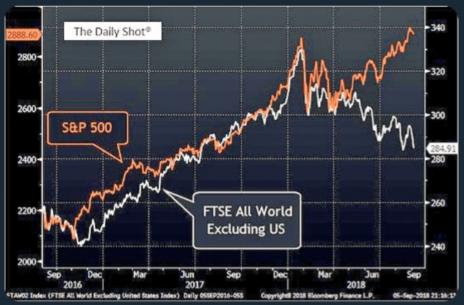Skepticism abounds as to how Donald Trump’s trade war will impact the U.S. economy long term. Short term, the impact on U.S. stocks has been minimal. Overseas, it’s a different story. Investors in international stocks are far more concerned about potential trade war headwinds than they are on Wall Street. For proof, check out this chart (courtesy of The Wall Street Journal’s Daily Shot) of the Vanguard FTSE All-World ex-U.S. ETF (VEU) vs. the S&P 500.
As the chart reveals, international stocks (in white) and U.S. stocks (in orange) were in virtual lockstep for 18 months, starting in September 2016. This April, they went in completely different directions, and have been growing further apart ever since. In the last five months, U.S. large cap stocks are up more than 6%, while stocks outside the U.S. have fallen 9% on average.
The Downfall of International Stocks: A Timeline
Technically, the trade war started in March, when President Trump signed a bill to impose tariffs on imported steel and aluminum from all countries, including China. But it really picked up steam in the first week of April, when the following back-and-forth occurred:
[text_ad use_post='129628']
April 2: China vows to impose $3 billion in tariffs on U.S. imports including fresh fruits, nuts, pork and wine.
April 3: The U.S. releases a tech-heavy list of imports against which $50 billion in tariffs will be levied, citing China’s abuses of intellectual property.
April 4: China says it will levy an additional 25% tariff on 106 U.S. imports including soybeans, cars and aircraft.
April 5: President Trump says he will consider another $100 billion in tariffs on Chinese imports.
There was more later in the month, but that was the exchange that essentially launched the downward spiral in international stocks—and Chinese stocks in particular. Since the beginning of April, the Golden Dragon China ETF (PGJ)—a fund that tracks the performance in prominent Chinese ADRs, and a favorite measuring stick of our emerging markets expert Paul Goodwin—is down 20%.
But China hasn’t been the only world market to get doused by the trade-war storm. Japanese stocks, German stocks, French stocks, and U.K. stocks all currently trade below their 50- and 200-day moving averages. Brazil’s Bovespa index is down more than 9% since the beginning of April—partly a byproduct of being one of America’s top steel suppliers.
To be fair, some global markets have been immune from the trade war—Canadian stocks are up more than 4% and Mexican stocks are up more than 5%, though both those markets have been propped up by the new (preliminary) NAFTA agreement. But by and large, international stocks have struggled, while U.S. stocks have continued to prosper.
Overseas Buying Opportunity?
That raises the question: after months of losses, is this a good time to buy low on international stocks—especially Chinese stocks? Here’s what Paul Goodwin had to say about the emerging markets landscape in his latest Cabot Global Stocks Explorer (formerly Cabot Emerging Markets Investor) issue:
“As some analysts are pointing out, we’re reaching a point where the correction in EM stocks is no longer about fundamentals and market realities. Increasingly, the focus is on possible contagion, a situation in which the selloff gains momentum and investors fuel the decline by cashing out of their EM holdings…
“…Fortunately, there are positive signs about some emerging market economies. India has taken China’s place as the fastest-growing major economy in the world, with an 8.2% hike in GDP growth in the second quarter. That’s a nice bump from Q1’s 7.7% growth. (That’s also a solid beat of expectations, as economists expected just 7.6% growth.)
“India is getting a definite boost from being firmly out of the line of fire in global trade wars, with a strong manufacturing sector and a domestically driven economy.
“China’s 6.7% Q2 growth puts it solidly in second place, with Indonesia taking the third spot with 5.3% GDP growth. Mexico is the next-strongest EM country with 2.6% growth.
“Eventually, when the trade wars end or are fully priced into investors’ expectations, emerging market stocks will bounce back and present some huge opportunities given the big declines this year. And we’ll be ready, having used our cash umbrella to avoid the downpour.”
When international stocks do get going again, you may want some help identifying the ones leading the charge. Subscribing to Paul’s Cabot Global Stocks Explorer advisor is the perfect place to find that help.
To learn more, click here.
[author_ad]
